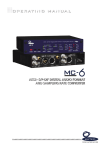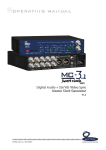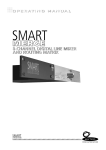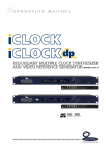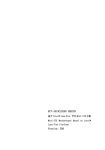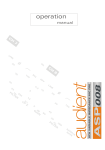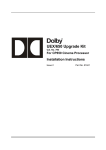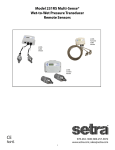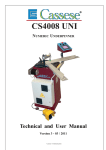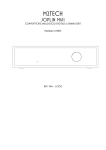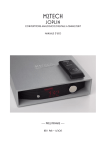Download Mutec MC-4 Technical data
Transcript
WORD CLOCK DISTRIBUTION AMPLIFIER & AUDIO CLOCK CONVERTER SAFETY INSTRUCTIONS General instructions To reduce the risk of fire or electrical shock, do not expose this appliance to rain or moisture, direct sunlight or excessive heat from sources such as radiators or spotlights. No user serviceable parts are inside. Repair and maintenance must be carried out by qualified personnel authorized by MUTEC GmbH! The unit has been designed for operation in a standard domestic environment. Do NOT expose the unit and its accessories to rain, moisture, direct sunlight or excessive heat produced by such heat sources as radiators or spotlights! The free flow of air inside and around the unit must always be ensured. Initial operation Prior to the initial operation of the unit, the appliance, its accessories and packaging must be inspected for any signs of physical damage that may have occurred during transit. If the unit has been damaged mechanically or if liquids have been spilled inside the enclosure, the appliance may not be connected to the mains or must be disconnected from the mains immediately! If the unit is damaged, please do NOT return it to MUTEC GmbH, but notify your dealer and the shipping company immediately, otherwise claims for damage or replacement may not be granted. If the device is left in a low-temperature environment for a long time and then is moved to a roomtemperature environment, condensation may occur on the inside and the exterior. To avoid shortcircuits and flashovers, be sure to wait one or two hours before putting the device into operation. Power supply The device contains a self-adapting wide-range power supply supporting the majority of global standard line voltages within a range of 90…250 V, with no need for making adjustments. Make sure that your line-voltage source provides a supply voltage within the specified range. In addition, make sure that the device is properly grounded via the local electric installation. Please use the enclosed power cord (see packaging) to connect the unit to the mains. Switch the unit off before you attempt to connect it to the mains. Connect the power cord to the unit, then to a standard 3-pin mains outlet. To draw the power cord, never pull on the cable but on the mains plug! C A U T I O N R I S K O F ELECTRICAL SHOCK! ! This symbol, a flash of lightning inside a triangle, alerts you to the presence of uninsulated dangerous voltage inside the enclosure - voltage that may be sufficient to constitute a risk of shock. ! This symbol, an exclamation mark inside a triangle, alerts you to important operating or safety instructions in this manual. Declaration of Conformity We herewith confirm that the product complies with the European Commission’s standards on electromagnetic compatibility. Interference emission: Resistance to interference: EN 50081-1, 1992 EN 50082-1, 1992 Presupposed as operation condition is that all clock outputs are connected with high-quality and good shielded BNC 75 ohms cable. The unit must be grounded during operation! For information on the power-inlet wiring, refer to the »Wiring of connectors« section in the appendix. Disconnect the device from the mains when not using it for an extended period! WARRANTY REGULATIONS §1 Warranty MUTEC GmbH warrants the flawless performance of this product to the original buyer for a period of two (2) years from the date of purchase. If any failure occurs within the specified warranty period that is caused by defects in material and/or workmanship, MUTEC GmbH shall either repair or replace the product free of charge within 90 days. The purchaser is not entitled to claim an inspection of the device free of charge during the warranty period. If the warranty claim proves to be justified, the product will be returned freight prepaid by MUTEC GmbH within Germany. Outside Germany, the product will be returned with the additional international freight charges payable by the customer. Warranty claims other than those indicated above are expressly excluded. §2 Warranty transferability This warranty is extended exclusively to the original buyer who bought the product from a MUTEC GmbH specialized dealer or distributor, and is not transferable to anyone who may subsequently purchase this product. No other person (retail dealer, distributor, etc.) shall be entitled to give any warranty promise on behalf of MUTEC GmbH. §3 Waranty regulations The return of the completed registration card, or online registration on one of the websites specified below, is a condition of warranty. Failing to register the device before returning it for repair will void the extended warranty. The serial number on the returned device must match the one stated on the registration card or entered during online registration. Otherwise, the device will be returned to the sender at the sender’s expense. Any returned device must be accompanied by a detailed error description and a copy of the original sales receipt issued by a MUTEC dealer or distributor. The device must be returned free of shipping expenses and in the original package, if possible; otherwise, the sender has to provide comparably protective packaging. The sender is fully responsible for any damage or loss of the product when shipping it to MUTEC GmbH. §4 Limitation of warranty Damages caused by the following conditions are not covered by this warranty: Damages caused by every kind of normal wear and tear (e.g. displays, LEDs, potentiometers, faders, switches, buttons, connecting elements, printed labels, cover glasses, cover prints, and similar parts). Functional failure of the product caused by improper installation (please observe CMOS components handling instructions!), neglect or misuse of the product, e.g. failure to operate the unit in compliance with the instructions given in the user or service manuals. Damage caused by any form of external mechanical impact or modification. Damage caused by the user’s failure to connect and operate the unit in compliance with local safety regulations. Damage caused by force majeure (fire, explosion, flood, lightning, war, vandalism, etc.). Consequential damages or defects in products from other manufacturers as well as any costs resulting from a loss of production. Repairs carried out by personnel which is not authorized from MUTEC GmbH will void the warranty. Adaptations and modifications to the device made with regard to national, technical, or safety regulations in a country or of the customer do not constitute a warranty claim and should be set with MUTEC GmbH in advance. §5 Repairs To obtain warranty service, the buyer must call or write to MUTEC GmbH before returning the unit. All inquiries must be accompanied by a description of the problem and the original buyer’s invoice. Devices shipped to MUTEC GmbH for repair without prior notice will be returned to the sender at the sender’s expense. In case of a functional failure please contact: MUTEC Gesellschaft fuer Systementwicklung und Komponentenvertrieb mbH Siekeweg 6/8 • 12309 Berlin • Germany • Fon 030-746880-0 • Fax 030-746880-99 • [email protected] • www.MUTEC-net.de JET and Jitter Elimination Technology are trademarks of TC Applied Technologies Ltd. The JET technology is used under sublicense from TC Applied Technologies Ltd., and is the intellectual property of Sonopsis Ltd. Applicable patents include WO2004088845. MUTEC GmbH assumes no liability for any incorrect information given in this manual. Please note that all software/hardware product names are registered trademarks of their respective owners. No part of this manual may be reproduced, copied or converted to a machine-readable form or electronical media without a written permission of MUTEC GmbH. We reserve the right to change or improve our products without prior notice. © MUTEC GmbH 2009 CONTENT INTRODUCTION General Function Description . . . . . . . . . . . . . . . . . 7 MC-7 Features . . . . . . . . . . . . . . . . . . . . . . . . . 7 MC-7 Applications . . . . . . . . . . . . . . . . . . . . . . . 7 Peripheral MUTEC Products . . . . . . . . . . . . . . . . . . 8 CONTROL ELEMENTS AND TERMINALS MC-7 Front Panel . . . . . . . . . . . . . . . . . . . . . . . . 9 MC-7 Rear Panel . . . . . . . . . . . . . . . . . . . . . . . . 10 INSTALLATION Content of the Box . . . . . . . . . . . . . . . . . . . . . . . 11 Placing the device . . . . . . . . . . . . . . . . . . . . . . . 11 Wiring the Word Clock Interfaces . . . . . . . . . . . . . . . 11 Wiring the AES/EBU and S/P-DIF Interfaces . . . . . . . . . . 12 GENERAL OPERATION Selecting Function Menus and setting Functions . . . . . . 13 Steps of Operation . . . . . . . . . . . . . . . . . . . . . . . 13 OPERATING THE MC-7 REFERENCE + CLK MULTIPLIERS Menus . . . . . . . . . . . . . . 15 General Operation Procedure . . . . . . . . . . . . . . . . . 15 Word Clock as Input Reference including Options . . . . . . 16 AES3/11 as Input Reference including Options . . . . . . . . 16 S/P-DIF coaxial as Input Reference including Options . . . . 17 S/P-DIF optical as Input Reference including Options . . . . 18 Multiplying Clock Rates . . . . . . . . . . . . . . . . . . . . 19 STATUS . . . . . . . . . . . . . . . . . . . . . . . . . . . . . 20 CLOCK IN . . . . . . . . . . . . . . . . . . . . . . . . . . . . 20 APPENDIX Pin Assignment of the Connectors . . . . . . . . . . . . . . 21 Switching-off the Termination of the Word Clock Input . . . 22 Generatable Clock Rates, Example: 44.1kHz . . . . . . . . . 23 Technical Data . . . . . . . . . . . . . . . . . . . . . . . . . 26 \B E D I E N E L E M E N T E >>>>>>>>>>>>>>>>>>>>>>>>>>>>>>>>>>>>>>>>>>>>>>>>>>>>>>>>>>>>>>>>>>>> INTRODUCTION Thank you very much for purchasing MC-7, Word Clock Distribution Amplifier and Audio Clock Converter, from MUTEC! General Function Description The MUTEC MC-7 is an extremely flexible, high-performance 8 channel Word Clock distribution amplifier and audio clock converter. The MC-7 distributes and converts Word Clock, AES3/11 and S/P-DIF signals. An incoming reference signal passes latest audiophil-optimized PLL circuits, to be distributed and output as low-jitter, high-quality clock signal, regardless of the condition of the reference signal. Thereby, connected audio devices will benefit from the MC-7’s signal regeneration abilities, which improve their sound qualities audibly. Furthermore, the MC-7 functions as multiplier for the clock rate of the incoming reference signal. Therefore, the outputs can be individually multiplied by x1, x2, x4, which leads to a very wide range of possible output Word Clock rates from 32.0kHz up to 768.0kHz. This enables e.g. the contemporaneous output of an incoming 48.0kHz reference signal with 96.0kHz, 192.0 kHz and as so-called Digidesign Super Clock. A special ‘Ref Pass’ functionality secures the availability of an incoming digital audio signal for further use. The grey boxes contain supplementary informationen for the corresponding sections in the text columns. The content of the individual box refers to the description in the text column beside the box. Boxes which contain a triangle with an exclamation mark inside should be read carefully! These include additional information which are of major importance for the functional descriptions in the text column. ! For live or broadcast use, a special ‘Hold’ functionality can be activated additionally. This function guarantees interruption-free output signal supply in cases when the external reference is of insufficient quality or lost completely. Thus, the MC-7 is predestined to be used as centralized clock stabilizer and distributor, where reliable signal availability is a must. Due to its synchronisation features and connection flexibility, the MC-7 offers unique possibilities to provide interconnections between digital audio devices on a reliable and useful basis. This all makes MC-7 for sure an unique and outstanding digital audio clock distributor and converter enabling to handle every clocking issue in your studio set-up with ease! MC-7 Features Distributes and converts Word Clock, AES3/11 and S/PDIF Extracts and re-generates clock signals out of digital audio signals Improves audio quality of connected devices Handles Word Clock rates from 32.0kHz up to 192.0kHz/768.0kHz Supports so-called Super Clocks for older Digidesign ProTools systems Offers 4 inputs and 11 outputs in total Protects from reference signal dropouts Supplies interruption-free output signals AES11, Grade 1, internal reference clock (0.5ppm) Easy to configure Compact case size fits in every studio set-up Built-in international power supply MC-7 Applications Stellate Word Clock distribution Sound improvement of digital audio devices Audiophil clock recovery and regeneration Interconnection of consumer and professional digital audio devices Line extension for e.g. theatre or broadcast installations Usable within small studio set-ups up to broadcast installations. Output expansion for MUTEC‘s iCLOCK, iCLOCKdp, iD, iDdp, MC-3, MC-3.1 and MC-3.2. > > > > > > > > > > > > > > > > > > > > > > > > > > > > > > > > > > > > > > > > > > > > > > > > > > > > > > > > > > > > > > > > > > > > 887 INTRODUCTION \\\\\\\\\\\\ >>>>>>>>>>>>>>>>>>>>>>>>>>>>>>>>>>>>>>>>>>>>>>>>>>>>>>>>>>>>>>>>>>>> Peripheral MUTEC Products Reference Clocks and Master Clocks for Synchronization: iCLOCK + iCLOCKdp iCLOCK and iCLOCKdp are synchronizable, high-precision clock generators which are designed to be the reference in digital audio and video studios as well as broadcast and television stations. For further details please visit: www.iCLOCK-NET.de MC-3 The MC-3 SMART CLOCK is an universal digital audio master clock generator. The unit provides different high-stable and Ultra low-jitter clock signals for synchronization of various digital audio devices. MC-3.1 The MC-3.1 SMART CLOCK SD is an universal digital audio and SD video sync master clock generator. The unit provides different high-stable clock signals for simultaneous synchronization of digital audio and SD video devices. MC-3.2 The MC-3.2 SMART CLOCK HD is an universal digital audio and SD/HD video sync master clock generator. The unit provides different highstable clock signals for simultaneous synchronization of digital audio and SD/HD video devices. Format and Sampling Rate Converters with internal Master Clock: MC-4 The MC-4 is a high-performance digital audio multichannel format and sampling rate converter for ADATTM, AES3 and S/P-DIF MC-6 The MC-6 is a high-performance digital audio dual channel format converter for AES3, AES3id and S/P-DIF. Cables for Digital Audio: Optical cables in different lenghts from 0.5 m to 20 m for ADATTM transfers. For all peripheral products please have a look on our website: www.MUTEC-NET.de ! 88 8 >>>>>>>>>>>>>>>>>>>>>>>>>>>>>>>>>>>>>>>>>>>>>>>>>>>>>>>>>>>>>>>>>>>> \B E D I E N E L E M E N T E >>>>>>>>>>>>>>>>>>>>>>>>>>>>>>>>>>>>>>>>>>>>>>>>>>>>>>>>>>>>>>>>>>>> CONTROL ELEMENTS AND TERMINALS MC-7 Front Panel 1 2 3 5 6 7 8 4 1 POWER This red LED lights up when the unit is switched on with the rear panel POWER switch. 2 MENU This key selects one of the available function menus. Refer to the OPERATIONS chapter for more information. 3 SELECT Use this key to select a function within a specific function menu. 4 REFERENCE This function menu allows to select all acceptable input reference signals for distribution or conversion. Furthermore, every input reference is available with two additional options: the »HOLD« function and the »REF PASS« function. See details in chapter OPERATING THE MC-7. 5 CLK MULTIPLIERS This functional menu lets you determine the factor by which the basis clock rate of the incoming reference signal is multiplied additionally. This setting can be made individually for every Word Clock pair of outputs as well as for the AES/EBU and S/P-DIF outputs. 6 STATUS This menu indicates various signal statuses of the incoming reference or digital audio signal. 7 CLOCK IN This menu indicates the clock rate of the incoming reference signal. Audio Clock rates between 32.0kHz and 192.0kHz can be analysed and displayed. 8 WCLK OUT 4 This pair of Word Clock outputs transfers either all standard Word Clock rates as well as Word Clock x 256 for older Digidesign ProTools™ systems. Its numbering is aligned to the functional menu »CLK MULTIPLIERS« on the front panel. For adjusting these outputs see chapter OPERATING THE MC-7. > > > > > > > > > > > > > > > > > > > > > > > > > > > > > > > > > > > > > > > > > > > > > > > > > > > > > > > > > > > > > > > > > > > > 889 CONTROL ELEMENTS \\\\\\\\\\\\\ >>>>>>>>>>>>>>>>>>>>>>>>>>>>>>>>>>>>>>>>>>>>>>>>>>>>>>>>>>>>>>>>>>>> MC-7 Rear Panel 1 For detailed specifications on all terminals, refer to the »Pin Assignment of the Connectors« and »Technical Data« in the chapter »APPENDIX«. 2 3 4 5 6 7 1 WCLK OUT 1–3 These 3 pairs of Word Clock outputs transfer either all standard Word Clock rates as well as so-called »Super Clock« rates (Word Clock x 256) for older Digidesign ProTools™ systems. Their numbering is aligned to the functional menu »CLK MULTIPLIERS« on the front panel. The individual BNC connectors of an output pair are marked as A and B. This allows, for example, for a simple documentation of the connected devices. For adjusting these outputs see chapter OPERATING THE MC-7. 2 S/P-DIF OUT 6 These two S/P-DIF outputs, available as optical (»OP«) and coaxial (»CO«) interfaces, transmit an optical S/P-DIF and an unbalanced electrical S/P-DIF digital audio or blank frame signal in compliance with the IEC 60958 standard. Their numbering is aligned to the corresponding functional menu on the front panel. For adjusting these outputs see chapter OPERATING THE MC-7. 3 AES3/11 OUT 5 This AES/EBU output transmits a transformer-balanced electrical AES3 or AES11 signal. Its numbering is aligned to the corresponding functional menu on the front panel. For adjusting this output see chapter OPERATING THE MC-7. 4 AES3/11 IN This AES/EBU input can receive a balanced digital AES3 or AES11 signal in compliance with AES3 –1992 (R1997) or AES11–1997/2003. The input impedance is 110 Ω (XLR connector, female). For selecting this input see chapter OPERATING THE MC-7. 5 S/P-DIF IN These two S/P-DIF inputs, available as optical (»OP«) and coaxial (»CO«) interfaces, receive an optical S/P-DIF and an unbalanced electrical S/P-DIF digital audio or blank frame signal in compliance with the IEC 60958 standard. For selecting one of these inputs see chapter OPERATING THE MC-7. 6 WCLK IN This input can receive a Word Clock or so-called »Super Clock« (Word Clock x 256) signal. The impedance of the connector is 75 Ω (BNC connectors, female). For selecting this input see chapter OPERATING THE MC-7. 7 MAINS IN, Power Switch + Power Inlet This is the main switch for switching the device on and off. Be sure to make all connections (especially the supplied power cable) properly before turning on the switch. Heed the SAFETY INSTRUCTIONS at the beginning of this manual. Connect the supplied power cable here. Make sure that the power switch is turned off before connecting the power cable to this inlet and to the power outlet. Line voltages within the range of 90…260V with a frequencies between 47...440Hz can be applied. The internal power supply will automatically make all necessary adjustments. 88 10 > > > > > > > > > > > > > > > > > > > > > > > > > > > > > > > > > > > > > > > > > > > > > > > > > > > > > > > > > > > > > > > > > > > > \B E D I E N E L E M E N T E >>>>>>>>>>>>>>>>>>>>>>>>>>>>>>>>>>>>>>>>>>>>>>>>>>>>>>>>>>>>>>>>>>>> INSTALLATION Content of the Box The unit was packed carefully. Nevertheless we recommend to check the content directly after opening the package: 1 x MC-7 1 x Power cable 4 x Rubber feet 1 x Manual 1 x Registration card The condition of the packaging material and the device should be checked carefully additionally. If there are any damages please refer to SAFETY INSTRUCTIONS, Initial Operation, and WARRANTY REGULATIONS. Placing the Device The unit should be set up as closely as possible to the devices to which it will be connected, so as to avoid excessive cable lengths. Use the 4 rubber feets enclosed with the appliance and stick them symmetrically on the bottom side of the unit to protect the enclosure and supporting surface from being damaged. The device can be mounted into a standard 19“ rack and will require 1 unit. In this case, the rubber feet cannot be attached. Install the device so that one unit of rack space is left free both above and below the device to allow for sufficient ventilation! The mounting depth including the terminals is 160 mm/6.7“. Another 60 mm/2.4“ should be added for the required cables. Additional slide-in rails on the rack inside are recommended for safe installation. This will also avoid long-term mechanical deformation of the housing. Before installing the unit the section SAFETY INSTRUCTIONS located at the beginning of this manual should be read carefully. ! Never expose the device and accessories to rain, moisture, direct sunlight, or excessive heat produced by radiators, heaters, or spot lights! Sufficient air circulation in the environment of the device must be ensured! ! Wiring the Word Clock interfaces To allow for the synchronization of signals, the interfaces of all devices involved must be properly connected to each other, so as to ensure a logical signal flow. Always be sure to connect the Word Clock output of the MC-4 to the corresponding input of the device you wish to synchronize. Cable lengths should be kept as short as possible to minimize signal losses and/or interferences! For the transmission of Word Clock signals electrical, unsymmetrical cables with a resistance of 75 Ω and BNC connectors on both ends are used. Typically, such cables are marked »RG-59U, RG59B/U«. Additionally, you should make sure that the Word Clock inputs to be connected to the MC-7’s outputs have a 75 Ω terminating resistor! Most Word Clock inputs allow for enabling/disabling the termination with a so-called »termination-switch«, which may be located on the outside or inside of the device. For devices which have no termination of the Word Clock input, e.g. RME Hammerfall with Word Clock i/o, Alesis BRC or M-Audio ProFire Lightbridge, you can use an additional BNC-T piece to terminate the input. Plug the T piece with its center connector into the input of the receiving device. Then, connect the cable coming from the MC-7’s Word Clock output to one of the lateral connectors, and the other connector of the BNC-T piece to a 75 Ω resistor forming the BNC termination. Basically, you should avoid »looping through« Word Clock leads by means of passive BNC-T pieces to preserve the signal quality, as level drops will be the result. If there is no other way to wire your set-up, please make sure that all Word Clock inputs (except for the last device in the chain) have their terminations disabled! In a serial Word Clock chain only the last clock input should have a termination! Never connect more than three devices in series to one output! It is imperative that the lengths of all cables connected are largely the same, as this is the only way to ensure that all devices will be synchronized in phase (exception: cable tolerances). ! Please make sure that the cable used has a resistance of 75 Ω, in compliance with the specifications! If a cable with a different resistance is used, a dramatic deterioration of the signal quality can be the result! In this case, the perfect synchronization of all devices involved could be impaired. We recommend using high-grade cables with a good shielding. A length of max. 10 meters (approx. 30 feets) should not be exceeded! MUTEC offers optical cables of various lengths that have been specifically tested for the transmission of S/P-DIF signals. Ask your local dealer for those cables! > > > > > > > > > > > > > > > > > > > > > > > > > > > > > > > > > > > > > > > > > > > > > > > > > > > > > > > > > > > > > > > > > > > > 88 11 I N S TALLAT I O N \\\\\\\\\\\\ >>>>>>>>>>>>>>>>>>>>>>>>>>>>>>>>>>>>>>>>>>>>>>>>>>>>>>>>>>>>>>>>>>>> Wiring the AES/EBU and S/P-DIF Interfaces Since some manufacturers offer optimized cables for the transmission of digital S/P-DIF and AES/EBU audio signals, it will be a good idea to ask your retailer for specific cables. Especially when working with high AES/EBU clock rates well shielded clock lines are imperative to avoid increased radiation! Standard cables are normally useable for clock rates up to 50.0kHz. Special shielded cable material should be used for transfer of higher clock rates. ! Connect the AES/EBU interfaces with the help of balanced electrical cables equipped with XLR connectors on both ends. The specifications stipulate a specific cable resistance of 110 Ω (ask your retailer for a confirmation of this value when purchasing the cables). Connect the coaxial S/P-DIF interface with the help of unbalanced electrical cables equipped with cinch connectors on both ends. The specifications stipulate a specific cable resistance of 75 Ω (ask your retailer for a confirmation of this value when purchasing the cables). Connect the optical S/P-DIF interface with the help of Toshiba TOSLINK™ compliant optical fiber cables. Here, you can use both plastic and glass fiber-based cables. When using plastic fiber cables, lengths of 10 meters should not be exceeded, so as to ensure the reliable transmission of signals. Glass fiber cables can transfer data reliably even over greater distances. MUTEC offers optical cables of various lengths that have been specifically tested for the transmission of S/P-DIF and ADAT™ signals (retailers and distributors only)! 88 12 > > > > > > > > > > > > > > > > > > > > > > > > > > > > > > > > > > > > > > > > > > > > > > > > > > > > > > > > > > > > > > > > > > > > \B E D I E N E L E M E N T E >>>>>>>>>>>>>>>>>>>>>>>>>>>>>>>>>>>>>>>>>>>>>>>>>>>>>>>>>>>>>>>>>>>> GENERAL OPERATION Selecting Function Menus and setting Functions The device is fully operated using the two toggle switches at the front panel. 1 Switching the MENU key toggles between different basic function menus. 2 Switching the SELECT key activtes individual functions within one function menu. For safety reasons, be sure to read the SAFETY INSTRUCTIONS and INSTALLATION chapters before first powering-up! We also recommend reading the CONTROL ELEMENTS AND TERMINALS chapter for information on how to connect MC-7! ! 2. SELECT selects individual functions within one function area. 1. MENU selects individual function menus. MENU + SELECT operation Functions Menus Function Areas + Functions Steps of Operation 1 First press on MENU or SELECT key enables the last selected function within the last selected function menu. The corresponding LED is beginning to flash. 2 Every press on SELECT key will select a new function within a menu. The LED of every selected function will flash accordingly and the corresponding function is vailable at once. 3 When the needed function is selected, do not press the switches again! After a period of approx. 4 seconds the LED in front of the selected function will stop flashing. ! All user-specific function settings are available furthermore when power is restored. The STATUS area is not accessible by using the MENU and SELECT switches, because it only informs about different conditions of incoming signals. > > > > > > > > > > > > > > > > > > > > > > > > > > > > > > > > > > > > > > > > > > > > > > > > > > > > > > > > > > > > > > > > > > > > 88 13 \B E D I E N E L E M E N T E >>>>>>>>>>>>>>>>>>>>>>>>>>>>>>>>>>>>>>>>>>>>>>>>>>>>>>>>>>>>>>>>>>>> OPERATING THE MC-7 REFERENCE + CLK MULTIPLIERS Menus These both menus are offering access to the whole functionality of your MC-7. The »REFERENCE« menu contains of two LED raws. With help of the first, left LED raw you select the input reference for distribution or signal conversion. The second LED raw within this menu signalizes special functionalities which can be added to the distribution or conversion process. Therefore both menus act together in different combinations. The »CLK MULTIPLIERS« menus allow for adding clock rate multipliers individually to the 4 Word Clock output pairs as well as to the AES3/11 and S/P-DIF outputs. Their numberings are aligned to the output numbers. The menus »STATUS« and »CLOCK IN« are for control of the MC-7‘s operation status only. They are not accessable for adjustments. General Operation Procedure The MC-7 menu is strictly organized aligned to generally usual handling procedures when inserting such a box into your studio set-up. So, you can split up all of the necessary adjustments in tow simple steps, which leads to the following three questions for the basic operation of your MC-7: 1) Which is my reference signal to be distributed → REFERENCE? WCLK = Word Clock or so-called Super Clock AES3/11 = AES3 or AES11 S/P-DIF co = S/P-DIF optical S/P-DIF op = S/P-DIF coaxial REFERENCE 2) Do I need increased output clock rates? → CLK MULTIPLIERS? x1 1 2 3 4 5 6 = x 1 of the reference signal‘s base clock rate x2 = x 2 of the reference signal‘s base clock rate x4 = x 4 of the reference signal‘s base clock rate x 256 = x 256 of the reference signal‘s base clock rate CLK MULTIPLIERS After these general decisions are made, your MC-7 is configured for optimal operation in your set-up! Due to the fact that the system monitors for useful function combinations, maloperation is not possible. So, let‘s have a look to the individual functions on the next pages. > > > > > > > > > > > > > > > > > > > > > > > > > > > > > > > > > > > > > > > > > > > > > > > > > > > > > > > > > > > > > > > > > > > > 88 15 O P E RAT I O N \\\\\\\\\\\\ >>>>>>>>>>>>>>>>>>>>>>>>>>>>>>>>>>>>>>>>>>>>>>>>>>>>>>>>>>>>>>>>>>>> Word Clock as Input Reference including Options 1 WCLK HOLD x1 AES3/11 REF PASS x2 REFERENCE Your MC-7 is able to lock to socalled »Super Clock« (SCLK) reference signals. These clock signals are used preferably for older digidesign ProTools™ MX systems. Specified are only two clock rates, 11.2896MHz + 12.288MHz which are the x256 multiples of the Word Clock rates 44.1kHz and 48.0kHz. When locking to one of these Super Clocks, the rate will be inverted displayed in the »REF CLOCK IN« menu. Due to this, the LED in front of the corresponding base clock rate, that means Word Clock rate, does not light while all other LEDs light (see examples below). 32.0 44.1 96.0 176.4 32.0 44.1 48.0 48.0 88.2 88.2 192.0 CLOCK IN Super Clock of 44.1kHz Word Clock 96.0 176.4 4 5 6 x 256 S/P-DIF op ! 3 x4 S/P-DIF co Locking so-called »Super Clocks« 2 CLK MULTIPLIERS This setting is the factory default and allows to input a Word Clock reference signal between 32.0kHz and 192.0kHz. Its clock rate will be displayed in the status menu »CLOCK IN«. The Word Clock reference signal will be internally regenerated and distributed phase-aligned to all eight Word Clock outputs. Simultaneously, the input signal will be converted into AES11 and S/P-DIF and output at the corresponding outputs. So, with one Word Clock reference signal you can synchronize various devices by Word Clock, AES11, S/P-DIF coaxial and S/P-DIF optical at the same time. 1 WCLK HOLD x1 AES3/11 REF PASS x2 2 3 4 5 6 x4 S/P-DIF co x 256 S/P-DIF op REFERENCE CLK MULTIPLIERS A special function can be added when pressing the SELECT key for a second time. This activates the »HOLD« function which leads to a fail-safe output of all outgoing signals. Interruptions within the input reference signal or even its total loss will not affect the continuous availability of all outgoing signals. 192.0 CLOCK AES3/11 as Input Reference including Options IN Super Clock of 48.0kHz Word Clock 1 WCLK HOLD x1 AES3/11 REF PASS x2 REFERENCE The AES3 standard carries both, the digital audio data and the reference clock information. The AES11, also know as ‚blank frame signal‘, does not carry any digital audio data, but only the reference clock information for synchronization. 4 5 6 x 256 S/P-DIF op Both standards, published by the Audio Engineering Society (AES), are based on the same interface, commonly called as AES/EBU interface which uses XLR connectors. 3 x4 S/P-DIF co Differences between AES3 and AES11 2 CLK MULTIPLIERS This setting allows to input an AES3 digital audio signal or an AES11 reference clock signal between 32.0kHz and 192.0kHz. Its clock rate will be displayed in the status menu »CLOCK IN«. The AES3/11 input signal will be regenerated and converted into Word Clock and S/P-DIF and transfered to the corresponding outputs simultaneously. If an AES3 digital audio signal is feed in, it will be standardly output as AES11 reference clock signal. Similarly, the digital audio data will be not transfered to the S/P-DIF outputs, but only the clock reference data for synchronization purposes. 1 WCLK HOLD x1 AES3/11 REF PASS x2 S/P-DIF co S/P-DIF op REFERENCE 2 3 4 5 6 x4 x 256 CLK MULTIPLIERS There are two further function options available when feeding in an AES3 or AES11 signal: »HOLD« + »REF PASS«. 88 16 > > > > > > > > > > > > > > > > > > > > > > > > > > > > > > > > > > > > > > > > > > > > > > > > > > > > > > > > > > > > > > > > > > > > O P E RAT I O N \\\\\\\\\\\\ >>>>>>>>>>>>>>>>>>>>>>>>>>>>>>>>>>>>>>>>>>>>>>>>>>>>>>>>>>>>>>>>>>>> When pressing the SELECT key for a further time, you can activate the »HOLD« function which leads to a fail-safe output of all outgoing signals. 1 WCLK HOLD x1 AES3/11 REF PASS x2 2 3 4 5 6 ! x4 S/P-DIF co x 256 S/P-DIF op REFERENCE CLK MULTIPLIERS When pressing the SELECT key again, you can activate the »REF PASS« function. This special function regenerates and transfers an AES3 input signal to the format-same output. In this case, the AES3/11 output transmits the original AES3 input signal incl. all digital audio data for further use within your studio set-up, while the other outputs supplying phase-aligned clock reference signals. S/P-DIF coaxial as Input Reference including Options 1 WCLK HOLD x1 AES3/11 REF PASS x2 2 3 4 5 6 x4 S/P-DIF co AES3 + REF PASS When feeding in an AES3 digital audio reference signal and using the REF PASS functionality, the digital audio signal will be only available at the formatsame AES3 output. There will be no digital audio format conversion to the S/P-DIF outputs! The S/P-DIF outputs transmit blank frame signals only. * While processing the AES3 signal, the PLL synthesizer circuit extracts the clock out of the AES3 signal, is re-generating it and is supplying it to all WCLK outputs. The WCLK output pairs can be multiplied individually by using the CLK Multipliers as mentioned at page 19. *) If you need to convert the AES3 format into S/P-DIF, please use the MUTEC MC-1 or MC-1.1. These converters are especially made for AES3 to S/P-DIF, and vice versa, digital audio format conversion. x 256 S/P-DIF op REFERENCE CLK MULTIPLIERS This setting allows to input a S/P-DIF digital audio or blank frame signal between 32.0kHz and 192.0kHz at the coaxial input. Its clock rate will be displayed in the status menu »CLOCK IN«. The S/P-DIF input signal will be regenerated and converted into Word Clock, AES11 and S/P-DIF optical and transfered to the corresponding outputs simultaneously. A S/P-DIF digital audio input signal will be standardly output as S/P-DIF blank frame signal for synchronization purposes at the coaxial and optical outputs. Similarly, the digital audio data will be not transfered to the AES3/11 output, but only the clock reference data. 1 WCLK HOLD AES3/11 REF PASS 2 3 4 5 6 x1 x2 ! x4 S/P-DIF co x 256 S/P-DIF op REFERENCE CLK MULTIPLIERS There are also two further function options available when feeding in an S/P-DIF coaxial signal: »HOLD« + »REF PASS«. When pressing the SELECT key for a further time, you can activate the »HOLD« function which leads to a fail-safe output of all outgoing signals. 1 WCLK HOLD x1 AES3/11 REF PASS x2 S/P-DIF co S/P-DIF op REFERENCE 2 3 4 5 6 x4 S/P-DIF coaxial + REF PASS When feeding in a S/P-DIF coaxial digital audio reference signal and using the REF PASS functionality, the digital audio signal will be only available at the format-same S/P-DIF coaxial/optical outputs. There will be no digital audio format conversion to the AES3/11 output! The AES3/11 output transmits the AES11 blank frame signal only. * While processing the S/P-DIF signal, the PLL synthesizer circuit extracts the clock out of the S/P-DIF signal, is re-generating it and is supplying it to all WCLK outputs. The WCLK output pairs can be multiplied individually by using the CLK Multipliers as mentioned at page 19. x 256 CLK MULTIPLIERS When pressing the SELECT key again, you can activate the »REF PASS« function. This special function regenerates and transfers a S/P-DIF coaxial input signal to the format-same output. In this case, the S/P-DIF output signal *) If you need to convert the S/P-DIF format into AES3, please use the MUTEC MC-1 or MC-1.1. These converters are especially made for AES3 to S/P-DIF, and vice versa, digital audio format conversion. 88 > > > > > > > > > > > > > > > > > > > > > > > > > > > > > > > > > > > > > > > > > > > > > > > > > > > > > > > > > > > > > > > > > > > > 17 ANHANG \\\\\\\\\\\\\\\\\\ >>>>>>>>>>>>>>>>>>>>>>>>>>>>>>>>>>>>>>>>>>>>>>>>>>>>>>>>>>>>>>>>>>>> includes all digital audio data for further use within your studio set-up, while the other outputs supplying phase-aligned clock reference signals. S/P-DIF optical as Input Reference including Options 1 WCLK HOLD x1 AES3/11 REF PASS x2 2 3 4 5 6 x4 S/P-DIF co x 256 S/P-DIF op REFERENCE CLK MULTIPLIERS This setting allows to input a S/P-DIF digital audio signal between 32.0kHz and 192.0kHz at the optical input. Its clock rate will be displayed in the status menu »CLOCK IN«. The S/P-DIF input signal will be regenerated and converted into Word Clock, AES11 and S/P-DIF coaxial and transfered to the corresponding outputs simultaneously. A S/P-DIF digital audio input signal will be standardly output as S/P-DIF blank frame signal for synchronization purposes at the optical and coaxial outputs. Similarly, the digital audio data will be not transfered to the AES3/11 output, but only the clock reference data. 1 WCLK HOLD AES3/11 REF PASS 2 3 4 5 6 x1 x2 x4 S/P-DIF co x 256 S/P-DIF op REFERENCE CLK MULTIPLIERS There are also two further function options available when feeding in an S/P-DIF optical signal: »HOLD« + »REF PASS«. When pressing the SELECT key for a further time, you can activate the »HOLD« function which leads to a fail-safe output of all outgoing signals. ! S/P-DIF optical + REF PASS When feeding in a S/P-DIF optical digital audio reference signal and using the REF PASS functionality, the digital audio signal will be only available at the format-same S/P-DIF coaxial/optical outputs. There will be no digital audio format conversion to the AES3/11 output! The AES3/11 output transmits the AES11 blank frame signal only. * While processing the S/P-DIF signal, the PLL synthesizer circuit extracts the clock out of the S/P-DIF signal, is re-generating it and is supplying it to all WCLK outputs. The WCLK output pairs can be multiplied individually by using the CLK Multipliers as mentioned at page 19. 1 WCLK HOLD AES3/11 REF PASS S/P-DIF co S/P-DIF op REFERENCE 2 3 4 5 6 x1 x2 x4 x 256 CLK MULTIPLIERS When pressing the SELECT key again, you can activate the »REF PASS« function. This special function regenerates and transfers a S/P-DIF optical input signal to the format-same output. In this case, the S/P-DIF output signal includes all digital audio data for further use within your studio set-up, while the other outputs supplying phase-aligned clock reference signals. *) If you need to convert the S/P-DIF format into AES3, please use the MUTEC MC-1 or MC-1.1. These converters are especially made for AES3 to S/P-DIF, and vice versa, digital audio format conversion. 18 > > > > > > > > > > > > > > > > > > > > > > > > > > > > > > > > > > > > > > > > > > > > > > > > > > > > > > > > > > > > > > > > > > > > 88 ANHANG \\\\\\\\\\\\\\\\\\ >>>>>>>>>>>>>>>>>>>>>>>>>>>>>>>>>>>>>>>>>>>>>>>>>>>>>>>>>>>>>>>>>>>> Multiplying Clock Rates 1 WCLK HOLD x1 AES3/11 REF PASS x2 S/P-DIF co S/P-DIF op REFERENCE 2 3 4 5 6 x4 x 256 CLK MULTIPLIERS With help of the clock multipliers (»CLK MULTIPLIERS«) you can add a clock rate multiplication factor to each pair of clock outputs. This is possible in any state of operation of your MC-7. The numbering of the multipliers is aligned to the output numbers. Select the prefered output with the MENU key and choose the needed multiplication factor by pressing the SELECT key accordingly. The factory default is set to x 1. The above mentioned front panel view shows the following adjustments as example: Generatable Clock Rates For a better understanding of the efficiency of the MC-7‘s clock multiplier, please refer to the tables »Generatable Clock Rates« on pages 23-25. There you can see which clock rates and clock signals the MC-7 is able to convert and to output simultaneously. Word Clock output pair no. 1 is set to x 1 Word Clock output pair no. 2 is set to x 2 Word Clock output pair no. 3 is set to x 256 Word Clock output pair no. 4 is set to x 4 AES3/11 output no. 5 is set to x 4 S/P-DIF outputs nos. 6 are set to x 2 »CLK MULTIPLIERs« 1 – 4 For every Word Clock output pair, nos. 1 – 4, are 4 multipliers available: x 1, x 2, x 4, x 256 The multiplication functions »x 1, x 2, x 4« multiply all available basis clocks up to the highest possible Word Clock rate of 768.0kHz (192.0kHz basis clock x 4). The function »x 256« refers only to the basis clocks of 44.1kHz and 48.0kHz of every incoming reference clock signal to output the so-called Super Clock rates, necessary for older digidesign ProTools™ MX systems. If a reference signal with a different clock rate, like e.g. 96,0kHz or 176.4kHz, comes in, the system identifies the included base clock rate and sets the multiplier accordingly to output only 44.1kHz x 256 or 48.0kHz x 256. The factory default is set at x 1. »CLK MULTIPLIER« 5 For the AES3/11 output no. 5 are 3 multipliers available: x 1, x 2, x 4 Due to the maximum possible AES3/11 clock frequency of 192.0kHz, the functions of these multipliers are depending on the basis clock rate of the incoming reference signal. The factory default is set at x 1. Example 1 The incoming basis clock runs at 32.0kHz, 44.1kHz or 48.0kHz: x 1: x 2: x 4: AES3/11 output runs at 32.0kHz, 44.1kHz or 48.0kHz AES3/11 output runs at 64.0kHz, 88.2kHz or 96.0kHz AES3/11 output runs at 128.0kHz, 176.4kHz or 192.0kHz Example 2 The incoming basis clock runs at 88.2kHz or 96.0kHz: x 1: x 2: x 4: AES3/11 output runs at 88.2kHz or 96.0kHz AES3/11 output runs at 176.4kHz or 192.0kHz AES3/11 output runs at 176.4kHz or 192.0kHz Example 3 The incoming basis clock runs at 176.4kHz or 192.0kHz: x 1: x 2: x 4: AES3/11 output runs at 176.4kHz or 192.0kHz AES3/11 output runs at 176.4kHz or 192.0kHz AES3/11 output runs at 176.4kHz or 192.0kHz > > > > > > > > > > > > > > > > > > > > > > > > > > > > > > > > > > > > > > > > > > > > > > > > > > > > > > > > > > > > > > > > > > > > 88 19 ANHANG \\\\\\\\\\\\\\\\\\ >>>>>>>>>>>>>>>>>>>>>>>>>>>>>>>>>>>>>>>>>>>>>>>>>>>>>>>>>>>>>>>>>>>> »CLK MULTIPLIER« 6 Both S/P-DIF outputs, optical and coaxial, transmit same clock rate settings. For the S/P-DIF output pair no. 6 are 3 multiply functions available: x 1, x 2, x 4 Due to the maximum possible S/P-DIF clock frequency of 192.0kHz, the functions of these multipliers are depending on the basis clock rate of the incoming reference signal. The factory default is set at x 1. Example 1 The incoming basis clock runs at 32.0kHz, 44.1kHz or 48.0kHz: x 1: x 2: x 4: S/PDIF outputs run at 32.0kHz, 44.1kHz or 48.0kHz S/PDIF outputs run at 64.0kHz, 88.2kHz or 96.0kHz S/PDIF outputs run at 128.0kHz, 176.4kHz or 192.0kHz Example 2 The incoming basis clock runs at 88.2kHz or 96.0kHz: x 1: x 2: x 4: S/PDIF outputs run at 88.2kHz or 96.0kHz S/PDIF outputs run at 176.4kHz or 192.0kHz S/PDIF outputs run at 176.4kHz or 192.0kHz Example 3 The incoming basis clock runs at 176.4kHz or 192.0kHz: x 1: x 2: x 4: S/PDIF outputs run at 176.4kHz or 192.0kHz S/PDIF outputs run at 176.4kHz or 192.0kHz S/PDIF outputs run at 176.4kHz or 192.0kHz STATUS This area displays different system conditions of your MC-7. There is no access for changing settings. »LOCK« This blue LED lights when the internal PLL circuit has detected the incoming clock reference signal as valid. If the reference signal is unstable or lost, the »LOCK« LED does not light. »HOLD« This red LED lights when the external reference clock signal is interrupted or lost and the HOLD functionality is selected in the REFERENCE menu. During this, all output signals are available continuously. STATUS »AUDIO« This red LED lights when a valid AES3 or S/P-DIF optical or coaxial digital audio reference signal is detected at the corresponding input. CLOCK IN This area displays the clock rate of the incoming reference clock signal. The following basis reference clock rates are supported and will be analyzed: Word Clock Rates 32.0kHz 44.1kHz 176.4kHz 192.0kHz 48.0kHz 88.2kHz 96.0kHz CLOCK IN These indications are only available if the internal PLL circuit is locked stably to the external reference signal and the corresponding blue LOCK LED lights permanently. Regarding the display of incoming Super Clock rates, please refer to page 16 under „Locking so-called »Super Clocks«“. 20 > > > > > > > > > > > > > > > > > > > > > > > > > > > > > > > > > > > > > > > > > > > > > > > > > > > > > > > > > > > > > > > > > > > > 88 \B E D I E N E L E M E N T E >>>>>>>>>>>>>>>>>>>>>>>>>>>>>>>>>>>>>>>>>>>>>>>>>>>>>>>>>>>>>>>>>>>> APPENDIX Pin Assignment of the Connectors Mains 3 2 1 1 2 3 Neutral (blue; USA: white) Protective earth (green/yellow; USA: green) Live, phase (brown; USA: black) Word Clock + Suber Clock BNC Input + Output 1 2 1 2 Signal Ground AES/EBU, XLR, Input 2 AES/EBU XLR Output 1 1 3 3 1 2 3 2 Audio ground a conductor (hot / +) b conductor (cold / -) S/PDIF Cinch Output 1 2 3 Ground a conductor (hot / +) b conductor (cold / -) S/PDIF Optical Output TOSLINK Standard 1 1 2 1 2 Audio signal Audio ground 1 Optical signal > > > > > > > > > > > > > > > > > > > > > > > > > > > > > > > > > > > > > > > > > > > > > > > > > > > > > > > > > > > > > > > > > > > > 88 21 AP P E N D I X \\\\\\\\\\\\ >>>>>>>>>>>>>>>>>>>>>>>>>>>>>>>>>>>>>>>>>>>>>>>>>>>>>>>>>>>>>>>>>>>> Switching-off the Termination of the Word Clock Input CAUTION! Disconnect the unit from the mains before opening! Remount the aluminium cover thoroughly before you attempt to operate the unit! Word Clock Input S/P-DIF Inputs When MC-7 is shipped, the BNC-based Word Clock input connector is terminated internally with 75 Ω. Therefore, one jumper is put on two pins - Position 2 - of the 3-pin socket JP1. JP1 Jumper: 1 2 Free Pin: Jumper Position 2 = Termination JP1 When moving the jumper from position 2 to position 1, the input termination will be switched-off. Therefore, the MC-7 must be connected in a chain, in which a device with terminated input follows. Otherwise you need to use a BNC-T piece in combination with a 75 Ω BNC resistor for terminating the MC-7’s input. 1 Termination 3-pin socket JP1 MC-7 Mainboard PCB 2 Jumper Position 1 = no Terminaltion For additional information regarding this issue, please refer to page 11. Word Clock Termination 88 22 > > > > > > > > > > > > > > > > > > > > > > > > > > > > > > > > > > > > > > > > > > > > > > > > > > > > > > > > > > > > > > > > > > > > AP P E N D I X \\\\\\\\\\\\ >>>>>>>>>>>>>>>>>>>>>>>>>>>>>>>>>>>>>>>>>>>>>>>>>>>>>>>>>>>>>>>>>>>> Generatable Clock Rates, Example: 44.1kHz as Input Clock Rate for all mentioned Input Signals WORD CLOCK SIGNAL AS INPUT REFERENCE Outputs Multiply x 1 Multiply x 2 Multiply x 4 Multiply x 256 Output Signal 1: Word Clock, A + B 44.1kHz 88.2kHz 176.4kHz Super Clock Clock Signal 2: Word Clock, A + B 44.1kHz 88.2kHz 176.4kHz Super Clock Clock Signal 3: Word Clock, A + B 44.1kHz 88.2kHz 176.4kHz Super Clock Clock Signal 4: Word Clock, A + B 44.1kHz 88.2kHz 176.4kHz Super Clock Clock Signal 5: AES3/11 44.1kHz 88.2kHz 176.4kHz None AES11, blank frame, none audio 6: S/P-DIF op + co 44.1kHz 88.2kHz 176.4kHz None S/P-DIF blank frame, none audio WORD CLOCK SIGNAL AS INPUT REFERENCE + HOLD FUNCTION Outputs Multiply x 1 Multiply x 2 Multiply x 4 Multiply x 256 Output Signal 1: Word Clock, A + B 44.1kHz 88.2kHz 176.4kHz Super Clock Clock Signal 2: Word Clock, A + B 44.1kHz 88.2kHz 176.4kHz Super Clock Clock Signal 3: Word Clock, A + B 44.1kHz 88.2kHz 176.4kHz Super Clock Clock Signal 4: Word Clock, A + B 44.1kHz 88.2kHz 176.4kHz Super Clock Clock Signal 5: AES3/11 44.1kHz 88.2kHz 176.4kHz None AES11, blank frame, none audio 6: S/P-DIF op + co 44.1kHz 88.2kHz 176.4kHz None S/P-DIF blank frame, none audio AES3 DIGITAL AUDIO SIGNAL AS INPUT REFERENCE Outputs Multiply x 1 Multiply x 2 Multiply x 4 Multiply x 256 Output Signal 1: Word Clock, A + B 44.1kHz 88.2kHz 176.4kHz Super Clock Clock Signal 2: Word Clock, A + B 44.1kHz 88.2kHz 176.4kHz Super Clock Clock Signal 3: Word Clock, A + B 44.1kHz 88.2kHz 176.4kHz Super Clock Clock Signal 4: Word Clock, A + B 44.1kHz 88.2kHz 176.4kHz Super Clock Clock Signal 5: AES3/11 44.1kHz 88.2kHz 176.4kHz None AES11, blank frame, none audio 6: S/P-DIF op + co 44.1kHz 88.2kHz 176.4kHz None S/P-DIF blank frame, none audio AES3 DIGITAL AUDIO SIGNAL AS INPUT REFERENCE + HOLD FUNCTION Outputs Multiply x 1 Multiply x 2 Multiply x 4 Multiply x 256 Output Signal 1: Word Clock, A + B 44.1kHz 88.2kHz 176.4kHz Super Clock Clock Signal 2: Word Clock, A + B 44.1kHz 88.2kHz 176.4kHz Super Clock Clock Signal 3: Word Clock, A + B 44.1kHz 88.2kHz 176.4kHz Super Clock Clock Signal 4: Word Clock, A + B 44.1kHz 88.2kHz 176.4kHz Super Clock Clock Signal 5: AES3/11 44.1kHz 88.2kHz 176.4kHz None AES11, blank frame, none audio 6: S/P-DIF op + co 44.1kHz 88.2kHz 176.4kHz None S/P-DIF blank frame, none audio AES3 DIGITAL AUDIO SIGNAL AS INPUT REFERENCE + REF PASS FUNCTION Outputs Multiply x 1 Multiply x 2 Multiply x 4 Multiply x 256 Output Signal 1: Word Clock, A + B 44.1kHz 88.2kHz 176.4kHz Super Clock Clock Signal 2: Word Clock, A + B 44.1kHz 88.2kHz 176.4kHz Super Clock Clock Signal 3: Word Clock, A + B 44.1kHz 88.2kHz 176.4kHz Super Clock Clock Signal 4: Word Clock, A + B 44.1kHz 88.2kHz 176.4kHz Super Clock Clock Signal 5: AES3/11 44.1kHz None None None AES3, digital audio signal 6: S/P-DIF op + co 44.1kHz None None None S/P-DIF blank frame, none audio AES11 BLANK FRAME SIGNAL AS INPUT REFERENCE Outputs Multiply x 1 Multiply x 2 Multiply x 4 Multiply x 256 Output Signal 1: Word Clock, A + B 44.1kHz 88.2kHz 176.4kHz Super Clock Clock Signal 2: Word Clock, A + B 44.1kHz 88.2kHz 176.4kHz Super Clock Clock Signal 3: Word Clock, A + B 4: Word Clock, A + B 5: AES3/11 44.1kHz 44.1kHz 44.1kHz 88.2kHz 88.2kHz 88.2kHz 176.4kHz 176.4kHz 176.4kHz Super Clock Super Clock None Clock Signal Clock Signal AES11, blank frame, none audio 6: S/P-DIF op + co 44.1kHz 88.2kHz 176.4kHz None S/P-DIF blank frame, none audio 88 > > > > > > > > > > > > > > > > > > > > > > > > > > > > > > > > > > > > > > > > > > > > > > > > > > > > > > > > > > > > > > > > > > > > 23 ANHANG \\\\\\\\\\\\\\\\\\ >>>>>>>>>>>>>>>>>>>>>>>>>>>>>>>>>>>>>>>>>>>>>>>>>>>>>>>>>>>>>>>>>>>> AES11 BLANK FRAME SIGNAL AS INPUT REFERENCE + HOLD FUNCTION Outputs Multiply x 1 Multiply x 2 Multiply x 4 Multiply x 256 Output Signal 1: Word Clock, A + B 44.1kHz 88.2kHz 176.4kHz Super Clock Clock Signal 2: Word Clock, A + B 44.1kHz 88.2kHz 176.4kHz Super Clock Clock Signal 3: Word Clock, A + B 4: Word Clock, A + B 5: AES3/11 44.1kHz 44.1kHz 44.1kHz 88.2kHz 88.2kHz 88.2kHz 176.4kHz 176.4kHz 176.4kHz Super Clock Super Clock None Clock Signal Clock Signal AES11, blank frame, none audio 6: S/P-DIF op + co 44.1kHz 88.2kHz 176.4kHz None S/P-DIF blank frame, none audio AES11 BLANK FRAME SIGNAL AS INPUT REFERENCE + REF PASS FUNCTION Outputs Multiply x 1 Multiply x 2 Multiply x 4 Multiply x 256 Output Signal 1: Word Clock, A + B 44.1kHz 88.2kHz 176.4kHz Super Clock Clock Signal 2: Word Clock, A + B 44.1kHz 88.2kHz 176.4kHz Super Clock Clock Signal 3: Word Clock, A + B 4: Word Clock, A + B 5: AES3/11 44.1kHz 44.1kHz 44.1kHz 88.2kHz 88.2kHz None 176.4kHz 176.4kHz None Super Clock Super Clock None Clock Signal Clock Signal AES11, blank frame, none audio 6: S/P-DIF op + co 44.1kHz None None None S/P-DIF blank frame, none audio S/P-DIF COAXIAL DIGITAL AUDIO SIGNAL AS INPUT REFERENCE Outputs Multiply x 1 Multiply x 2 Multiply x 4 Multiply x 256 Output Signal 1: Word Clock, A + B 44.1kHz 88.2kHz 176.4kHz Super Clock Clock Signal 2: Word Clock, A + B 44.1kHz 88.2kHz 176.4kHz Super Clock Clock Signal 3: Word Clock, A + B 4: Word Clock, A + B 5: AES3/11 44.1kHz 44.1kHz 44.1kHz 88.2kHz 88.2kHz 88.2kHz 176.4kHz 176.4kHz 176.4kHz Super Clock Super Clock None Clock Signal Clock Signal AES11, blank frame, none audio 6: S/P-DIF op + co 44.1kHz 88.2kHz 176.4kHz None S/P-DIF blank frame, none audio S/P-DIF COAXIAL DIGITAL AUDIO SIGNAL AS INPUT REFERENCE + HOLD FUNCTION Outputs Multiply x 1 Multiply x 2 Multiply x 4 Multiply x 256 Output Signal 1: Word Clock, A + B 44.1kHz 88.2kHz 176.4kHz Super Clock Clock Signal 2: Word Clock, A + B 44.1kHz 88.2kHz 176.4kHz Super Clock Clock Signal 3: Word Clock, A + B 4: Word Clock, A + B 5: AES3/11 44.1kHz 44.1kHz 44.1kHz 88.2kHz 88.2kHz 88.2kHz 176.4kHz 176.4kHz 176.4kHz Super Clock Super Clock None Clock Signal Clock Signal AES11, blank frame, none audio 6: S/P-DIF op + co 44.1kHz 88.2kHz 176.4kHz None S/P-DIF blank frame, none audio S/P-DIF COAXIAL DIGITAL AUDIO SIGNAL AS INPUT REFERENCE + REF PASS FUNCTION Outputs Multiply x 1 Multiply x 2 Multiply x 4 Multiply x 256 Output Signal 1: Word Clock, A + B 44.1kHz 88.2kHz 176.4kHz Super Clock Clock Signal 2: Word Clock, A + B 44.1kHz 88.2kHz 176.4kHz Super Clock Clock Signal 3: Word Clock, A + B 4: Word Clock, A + B 5: AES3/11 44.1kHz 44.1kHz 44.1kHz 88.2kHz 88.2kHz None 176.4kHz 176.4kHz None Super Clock Super Clock None Clock Signal Clock Signal AES11, blank frame, none audio 6: S/P-DIF op + co 44.1kHz None None None S/P-DIF digital audio signal * S/P-DIF OPTICAL DIGITAL AUDIO SIGNAL AS INPUT REFERENCE Outputs Multiply x 1 Multiply x 2 Multiply x 4 Multiply x 256 Output Signal 1: Word Clock, A + B 44.1kHz 88.2kHz 176.4kHz Super Clock Clock Signal 2: Word Clock, A + B 44.1kHz 88.2kHz 176.4kHz Super Clock Clock Signal 3: Word Clock, A + B 4: Word Clock, A + B 5: AES3/11 44.1kHz 44.1kHz 44.1kHz 88.2kHz 88.2kHz 88.2kHz 176.4kHz 176.4kHz 176.4kHz Super Clock Super Clock None Clock Signal Clock Signal AES11, blank frame, none audio 6: S/P-DIF op + co 44.1kHz 88.2kHz 176.4kHz None S/P-DIF blank frame, none audio 24 > > > > > > > > > > > > > > > > > > > > > > > > > > > > > > > > > > > > > > > > > > > > > > > > > > > > > > > > > > > > > > > > > > > > 88 ANHANG \\\\\\\\\\\\\\\\\\ >>>>>>>>>>>>>>>>>>>>>>>>>>>>>>>>>>>>>>>>>>>>>>>>>>>>>>>>>>>>>>>>>>>> S/P-DIF OPTICAL DIGITAL AUDIO SIGNAL AS INPUT REFERENCE + HOLD FUNCTION Outputs Multiply x 1 Multiply x 2 Multiply x 4 Multiply x 256 Output Signal 1: Word Clock, A + B 44.1kHz 88.2kHz 176.4kHz Super Clock Clock Signal 2: Word Clock, A + B 44.1kHz 88.2kHz 176.4kHz Super Clock Clock Signal 3: Word Clock, A + B 4: Word Clock, A + B 5: AES3/11 44.1kHz 44.1kHz 44.1kHz 88.2kHz 88.2kHz 88.2kHz 176.4kHz 176.4kHz 176.4kHz Super Clock Super Clock None Clock Signal Clock Signal AES11, blank frame, none audio 6: S/P-DIF op + co 44.1kHz 88.2kHz 176.4kHz None S/P-DIF blank frame, none audio S/P-DIF OPTICAL DIGITAL AUDIO SIGNAL AS INPUT REFERENCE + REF PASS FUNCTION Outputs Multiply x 1 Multiply x 2 Multiply x 4 Multiply x 256 Output Signal 1: Word Clock, A + B 44.1kHz 88.2kHz 176.4kHz Super Clock Clock Signal 2: Word Clock, A + B 44.1kHz 88.2kHz 176.4kHz Super Clock Clock Signal 3: Word Clock, A + B 4: Word Clock, A + B 5: AES3/11 44.1kHz 44.1kHz 44.1kHz 88.2kHz 88.2kHz None 176.4kHz 176.4kHz None Super Clock Super Clock None Clock Signal Clock Signal AES11, blank frame, none audio 6: S/P-DIF op + co 44.1kHz None None None S/P-DIF digital audio signal * *) Both S/P-DIF outputs are supplying the same digital audio signal with same content, but electrically converted into a coaxial and an optical signal. 88 > > > > > > > > > > > > > > > > > > > > > > > > > > > > > > > > > > > > > > > > > > > > > > > > > > > > > > > > > > > > > > > > > > > > 25 ANHANG \\\\\\\\\\\\\\\\\\ >>>>>>>>>>>>>>>>>>>>>>>>>>>>>>>>>>>>>>>>>>>>>>>>>>>>>>>>>>>>>>>>>>>> Technical Data WORD CLOCK INPUT Interface 1 x BNC, 200 mV-7 V, unbalanced, input impedance 75 Ω Lock range 25.0kHz to 200.0 kHz, 11.2896MHz + 12.288MHz (so-called Super Clocks) AES3/11 INPUT Interface 1 x XLR female, transformer balanced, input impedance 110 Ω, 200 mV – 7.0 V Format, Resolution AES3 – 1992/2003, AES11 – 1997/2003, 16 – 24 bits Lock range 25.0kHz to 200.0kHz S/P-DIF COAXIAL INPUT (CO) Interface 1 x Coaxial (Cinch/RCA female), unbalanced, 0.5 Vpp @ 75 Ω, output impedance 75 Ω Format, Resolution IEC 60958, 16 – 24 bits Lock range 25.0kHz to 200.0kHz S/P-DIF OPTICAL INPUT (OP) Interface 1 x ToslinkTM, EIAJ RC-5720 Format, Resolution IEC 60958, 16 – 24 bits Lock range 25.0kHz to 200.0kHz WORD CLOCK OUTPUTS Interface 8 x BNC, 3,5 V @ 22 Ω, unbalanced, buffered Transmitted clock rates 25.0kHz to 200.0kHz, 11.2896MHz + 12.288MHz (so-called Super Clocks) AES3/11 OUTPUT Interface 1 x XLR male, transformer balanced, 3.5Vpp @ 110Ω, output impedance 110Ω, buffered Format, Resolution AES3 – 1992/2003, AES11 – 1997/2003, 24 bits Transmitted sampling rates 25.0kHz to 200.0kHz S/P-DIF COAXIAL OUTPUT (CO) Interface 1 x BNC, 200 mV-7 V, unbalanced, input impedance 75 Ω, buffered Format, Resolution IEC 60958, 24 bits Transmitted sampling rates 25.0kHz to 200.0 kHz S/P-DIF OPTICAL OUTPUT (OP) Interface 1 x Toshiba ToslinkTM, EIAJ RC-5720 Format, Resolution IEC 60958, 24 bits Transmitted sampling rates 25.0kHz to 200.0kHz INTERNAL REFERENCE CLOCK SPECIFICATIONS Oscillator type TCXO, temperature compensated crystal oscillator Clock accuracy (shipped) < ± 0.5ppm Clock stability vs. temperature < ± 0.5ppm within -10°C to + 60°C Operating temperature -10°C to + 60°C Clock jitter < 10ps (RMS) POWER SUPPLY Type Internal, switching power supply Input voltage 85V – 264V (automatic adjustment), 47Hz – 440Hz Power consumption max. 10W SYSTEM UNIT COVER Cover size / material / color 196 x 42 x 156mm without connectors (W x H x D), aluminium sheet 1mm, black Front panel size / material 198 x 44 x 2mm (W x H x D), aluminium Weight ~ 750g 26 > > > > > > > > > > > > > > > > > > > > > > > > > > > > > > > > > > > > > > > > > > > > > > > > > > > > > > > > > > > > > > > > > > > > 88 >>>>>>>>>>>>>>>>>>>>>>>>>>>>>>>>>>>>>>>>>>>>>>>>>>>>>>>>>>>>> ALL SOFTWARE AND HARDWARE PRODUCT NAMES ARE REGISTERED TRADEMARKS OF THEIR RESPECTIVE OWNERS. WE RESERVE THE RIGHT TO CHANGE TECHNICAL DETAILS WITHOUT PRIOR NOTICE. ©MUTEC GmbH 2002 •7045-014 WWW.MUTEC-NET.DE FON 0049-(0)30-746880-0 FAX 0049-(0)30-746880-99




























